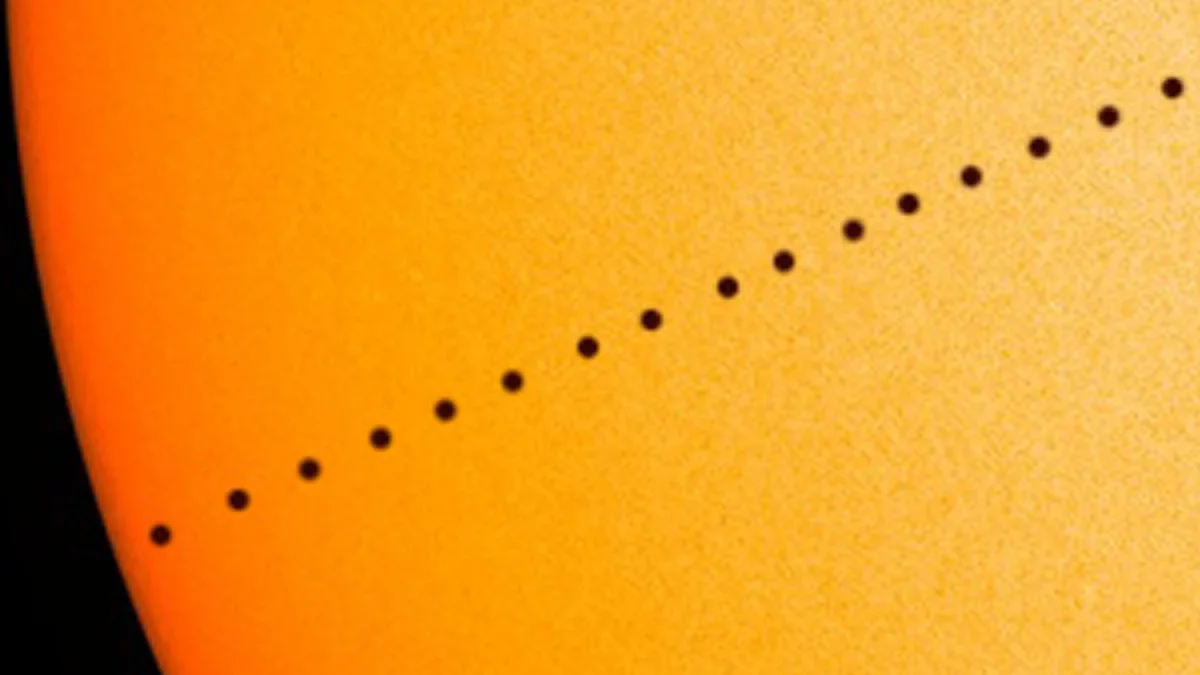
Witness a rare transit of Mercury on Monday. Here's how
There are plenty of ways to watch this transit of Mercury, here are the best
Among all the events happening in the sky during the next few months, a special show put on by the planet Mercury promises to be the best of them!
On November 11, 2019, Mercury will line up directly between the Sun and Earth to perform what is known as a 'transit'.
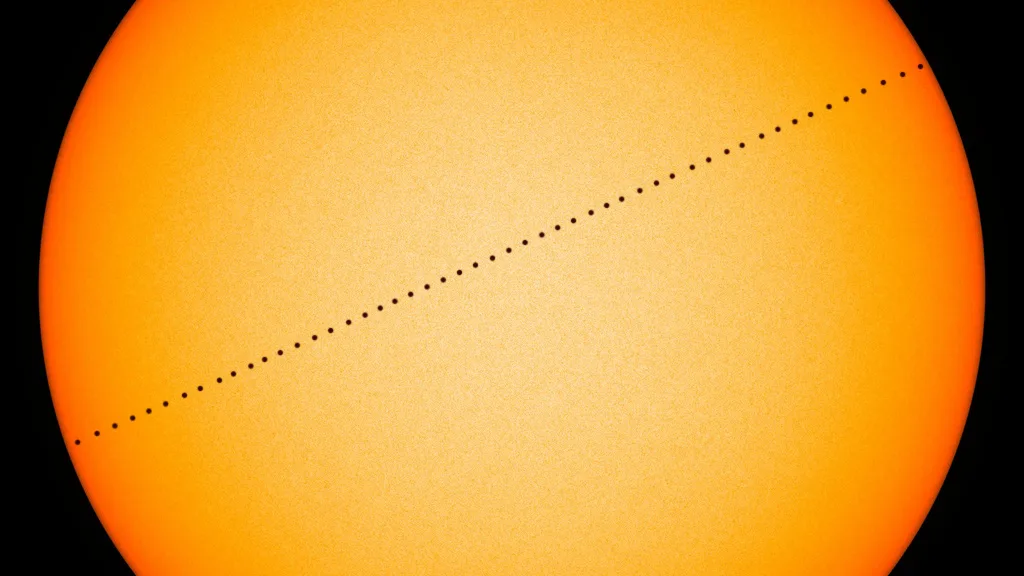
This simulated time-lapse view of the November 11, 2019 transit of Mercury traces the planet's path across the Sun. Credit: NASA/Scott Sutherland
Over the course of roughly five and a half hours, from 7:35 a.m. EST to 1:04 p.m. EST, the tiny planet will show up as a small dark circle crossing the face of the Sun!
This is exactly how astronomers look for alien worlds around other stars!
The transit event will be visible only during the daytime, and only through a telescope equipped with a special solar filter that blocks out the harmful rays of the Sun. It can also be viewed online via NASA's Solar Dynamics Observatory, or through one of the many livestreams that will be available.
The best viewing in Canada will be from the Maritimes, Quebec, and anywhere in Ontario east of Lake Superior.
For anyone in those areas, the transit will start after sunrise and there is a chance to see all 5.5 hours of it, from start to finish (weather permitting).
Newfoundland (NST): starts at 9:05 a.m., ends at 2:34 p.m.
NS, PEI, NB, Labrador (AST): starts at 8:36 a.m., ends at 2:04 p.m.
Quebec, eastern Ontario (EST): starts at 7:36 a.m., ends at 1:04 p.m.
Anywhere west of the eastern shores of Lake Superior will see the eclipse already in progress as the Sun rises (also, with weather permitting).
Thunder Bay (EST): Sunrise at 7:58 a.m., ends at 1:04 p.m.
Winnipeg (CST): Sunrise at 7:34 a.m., ends at 12:04 p.m.
Regina (CST): Sunrise at 8:05 a.m., ends at 12:04 p.m.
Calgary (MST): Sunrise at 7:45 a.m., ends at 11:04 a.m.
Vancouver (PST): Sunrise at 7:16 a.m., ends at 10:04 a.m.
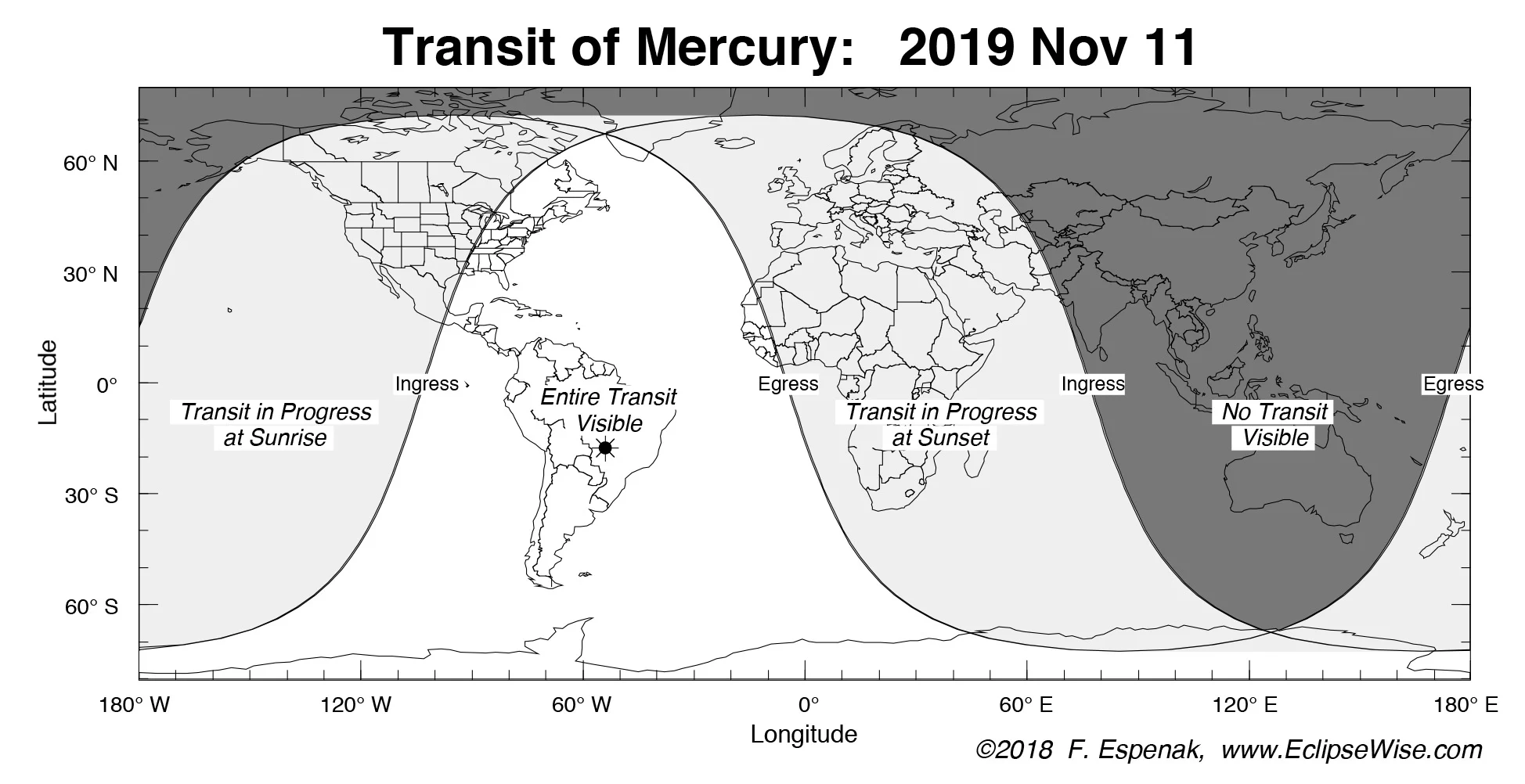
This map shows the best places to view the Transit of Mercury. Credit: Eclipse Predictions by Fred Espenak, www.EclipseWise.com
A RARE EVENT
The last time we saw a transit of Mercury was on May 9, 2016. That was only three and a half years before this one, which may not seem very 'rare'.
It certainly is rare, however, when you consider that Mercury has passed between Earth and the Sun 14 times since 2016, with no transits.
Why? For the same reason we only rarely see solar eclipses here on Earth. The Moon's orbit around Earth doesn't trace along the equator, but instead is tilted by about five degrees off the equator. At the distance the Moon is from Earth, that's just enough so that whenever we have a New Moon - when the Moon passes between the Sun and Earth - most of the time, the Moon's shadow slipped past Earth, either above or below the planet. It's only rarely that everything lines up nicely and the shadow passes across Earth, giving us an eclipse.
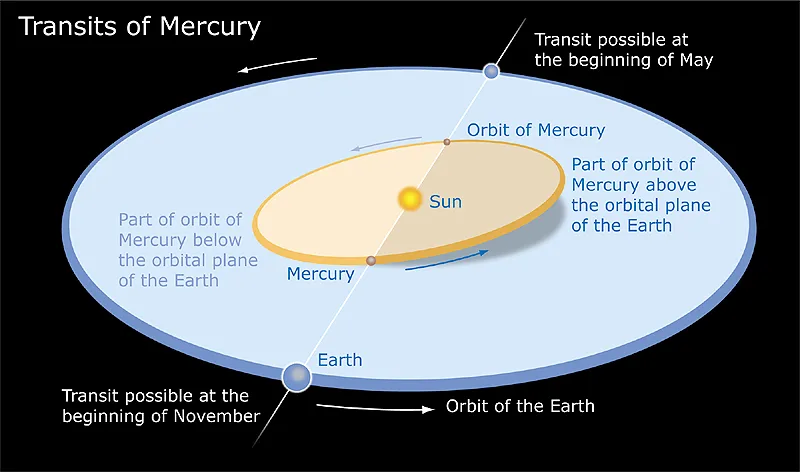
The tilted orbit of Mercury. Credit: European Southern Observatory
Because Mercury's orbit around the Sun is tilted with respect to Earth's orbit, we see the same thing. Most of the time, when Mercury passes between the Sun and Earth, it is either above or below the Sun, from our perspective. It's only rare occasions like this that everything lines up perfectly.
Remarkably, due to Mercury's tilted orbit, we can only see the planet transit at two times of the year, in either May or November. These just happen to be the two times of each Earth year that we are passing by the point where Mercury passes through the ecliptic plane. We just need Mercury to show up at one of those two points at just the right time to see it pass in front of the Sun.
HOW TO WATCH
The transit of Mercury begins at 7:36 a.m. EST on Monday, November 11, 2019, and it takes roughly 5.5 hours for it to trace its path across the Sun.
To view the event, there are several options.
To start, if you want to see it for yourself, check your local weather forecast to see if you will have clear skies.
As of Sunday, the forecast looks good for nearly all of Canada except Ontario and Quebec. The cloudy skies that are accompanying Monday's snowstorm will make viewing the transit impossible. See Ontario's Forecast. See Quebec's Forecast.
For those with clear skies, you will definitely need a telescope to view this event. Unfortunately, the dot of Mercury will be too small to see with the naked eye, even if you are wearing your Mylar eclipse glasses from the 2017 Solar Eclipse.
Important Reminders: Please do not take chances with your eyesight. Never look directly at the Sun without some kind of special eye protection. NEVER, NEVER look directly at the Sun with an unfiltered telescope or unfiltered binoculars, even with eye protection. This may damage the lenses of the scope or binoculars, and focused sunlight can burn directly through Mylar eclipse glasses, resulting in permananet eye damage.
Any telescope used to view it should be a fairly good one. Fred Espenak, in the RASC Observers Handbook 2019, recommends at least a 50x magnification to resolve Mercury against the backdrop of the Sun.
Most importantly, it is essential to use a solar filter, specifically one that fits over the telescope's aperture - the end of the telescope tube that is pointed at the target being viewed. This will ensure that you not only protect your eyes, but also your telescope.
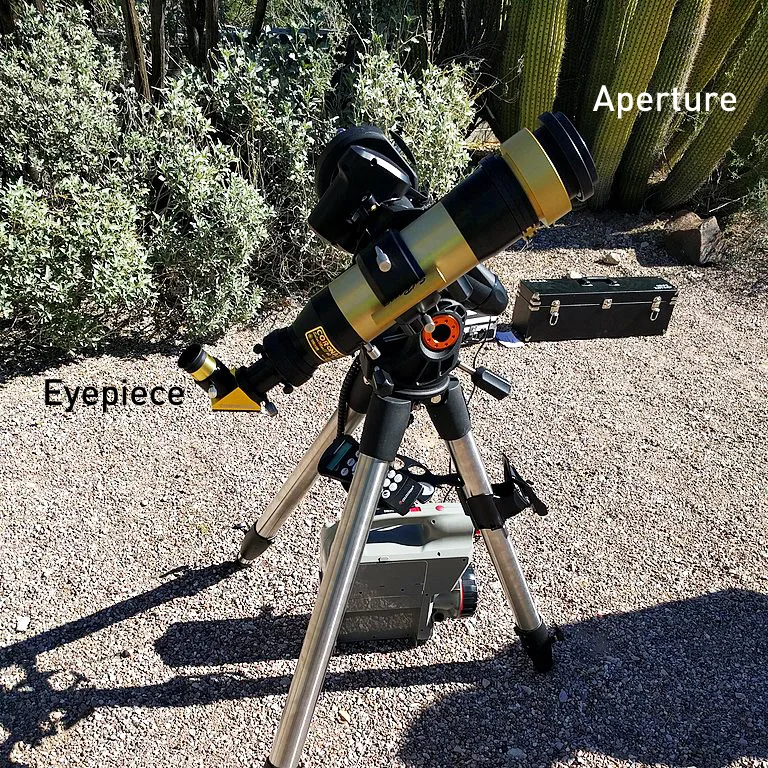
This refractor telescope has been set up to view the Sun, with a solar filter over its aperture. Credit: Photo by Brewbooks/Wikimedia Commons, labels by Scott Sutherland
Some older telescopes included a small welder's glass filter that screwed into the bottom of the eyepiece. These are no longer recommended and should be thrown out in favour of a more modern solar filter. The right kind of welder's glass does protect against unfocused sunlight (specifically #14 welder's glass). Focused sunlight, however, can damage the telescope's lenses and it can even crack the filter, allowing a searing beam of sunlight straight into your eye. (Hat tip to Mike Simmons, from Astronomers without Borders, for this update.)
Again, please do not put on a pair of eclipse glasses and then try to view the event through unfiltered binoculars or an unfiltered telescope. Focused sunlight will surely burn straight through a thin film of Mylar, exposing your eyes to harm. Trying to hold up a pair of binoculars behind a pair of eclipse glasses is also just not recommended. Please do not take chances with your eyesight.
To share the event with others, and if you don't have a telescope, yourself, check with the Royal Astronomical Society of Canada (RASC) centres, various astronomy clubs and Canada's Science Centres to see if they have set up special viewing events.
The Space Matters website also has a map of organizations and events.
For those who are unfortunately snowed in for the morning, or who cannot make it to one of the outdoor events, NASA's Solar Dynamics Observatory will be watching the event from space, which the space agency will post images of in near-realtime.
The '171 Angstrom' view of the Sun, shown below, is likely the best one to watch the transit as it happens. It presents the best combination of bright background and quickest updates.
Click or tap the image to enlargify, and be sure to refresh it every 10-15 minutes to see Mercury crawl across the face of the Sun! Credit: NASA SDO
Also, there will be various livestreamed feeds from different parts of the world, available to watch online. The team at Slooh will be streaming the transit, with commentary, starting at 7:30 a.m. EST, both on their website and on Facebook. You can also watch from the famous Griffith Observatory in Los Angeles, starting at 9:15 a.m. EST, as they train their telescopes onto the Sun for the event from the west coast.
Check back for updates, and read more for what else you can see in the sky this season.
